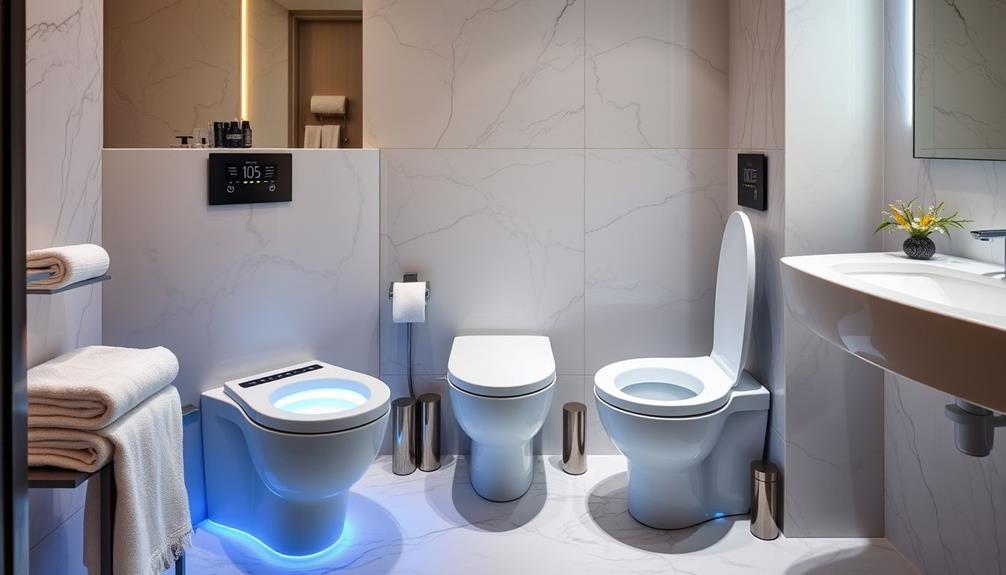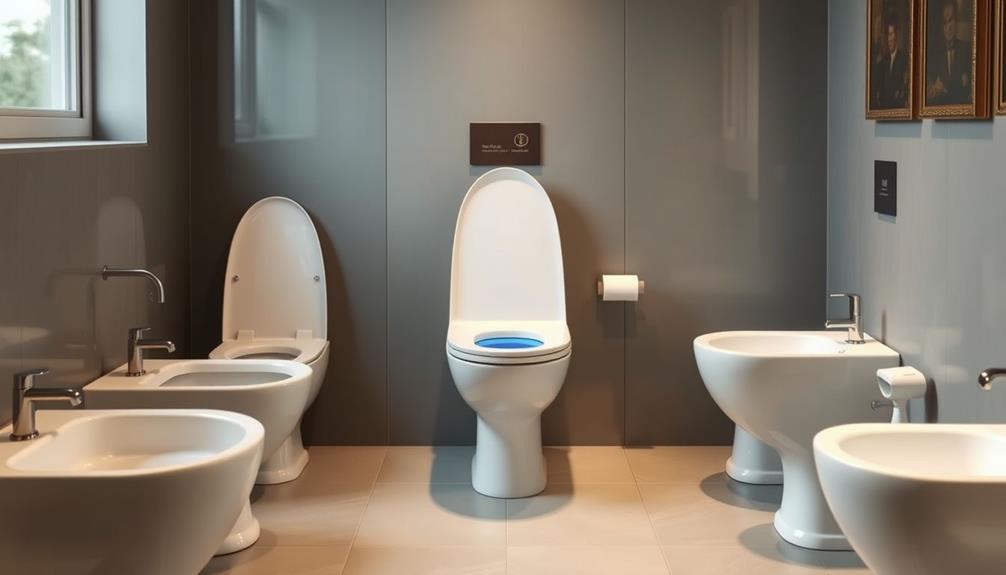Have you ever found yourself in the frustrating situation of having a broken toilet handle? Trust me, I’ve been there. It’s a nuisance that can disrupt your daily routine.
But fear not! In this article, I will guide you through the step-by-step process of flushing a toilet with a broken handle. From assessing the situation to finding alternative flushing techniques, I’ve got you covered.
So, let’s get started and put an end to this pesky problem once and for all.
Key Takeaways
- Assess whether the handle is completely detached or just loose
- Check if the chain is intact and connected to the lever
- Grip the lever firmly and apply downward pressure to engage the flush mechanism
- Use alternative flushing techniques like manually lifting the flapper valve or pouring water directly into the bowl
Assessing the Broken Handle Situation
Before attempting to flush the toilet, you should determine the extent of the broken handle situation. Diagnosing the problem will help you troubleshoot the right solutions.
Start by inspecting the handle to see if it’s completely detached or just loose. If it’s detached, you may need to replace the handle entirely. However, if it’s just loose, you can try tightening the screws or bolts that hold it in place. If tightening doesn’t work, the handle may be stripped, and you’ll need to replace it.
Another possible issue could be a broken chain or a disconnected lever inside the tank. Check if the chain is intact and connected to the lever. If it’s broken or disconnected, reattach or replace it accordingly.
Locating the Flush Mechanism
To locate the flush mechanism on a toilet with a broken handle, you can try feeling for a small lever on the side of the tank. This lever is usually located towards the bottom or near the center of the tank. It is connected to a chain or rod that controls the flushing action.
If you can’t find the lever by feeling around, you may need to remove the tank lid. Once you locate the lever, you can troubleshoot any flushing issues by checking if the chain or rod is properly connected and not tangled or broken. If it is broken, you can consider DIY handle replacement options, which we will discuss in the next section.
Manipulating the Flush Mechanism
Now that you’ve found the lever, you can easily manipulate it to initiate a successful flush. To help you understand the process better, let me break it down for you step-by-step.
First, locate the flush mechanism, which is usually a lever on the side or front of the toilet tank. Once you’ve found it, follow these simple steps:
- Grip the lever firmly with your hand.
- Apply downward pressure to engage the flush mechanism.
- Hold the lever down for a few seconds to ensure a complete flush.
- Release the lever and let it return to its original position.
By following these steps, you can successfully flush the toilet even with a broken handle.
Now, let’s move on to the next section where we will explore alternative flushing techniques for emergency situations.
Using Alternative Flushing Techniques
If you’re in an emergency situation, there are alternative techniques you can use to successfully initiate a flush without a functional handle.
Here are a few improvising techniques that can help you solve this problem quickly and efficiently.
First, check if there is a chain connected to the flapper inside the tank. If there is, give it a gentle tug to activate the flush.
If there is no chain or it’s broken, locate the water valve behind the toilet and turn it off. Then, remove the tank lid and manually lift the flapper valve, allowing the water to rush into the bowl.
Finally, you can also try pouring a bucket of water directly into the bowl to create enough pressure and force the water down the drain.
These emergency solutions will help you overcome a broken handle and keep your toilet functioning properly.
Temporary Fixes for the Broken Handle
One option you have is using a temporary fix to quickly solve the issue with the handle.
When faced with a broken toilet handle, there are a few emergency flushing methods you can try to keep your toilet functional.
First, remove the lid of the toilet tank to access the inner workings. Look for a long rod or lever near the flapper valve. Gently push or pull this rod to trigger the flushing mechanism.
Another option is to use a bucket of water. Fill a bucket with water and pour it directly into the toilet bowl. The force of the water should be enough to flush the toilet. Remember to pour the water quickly and from a height to maximize the flushing power.
These temporary fixes can help you maintain a working toilet until the handle is repaired or replaced.
Repairing or Replacing the Handle
When faced with a broken toilet handle, there are a few alternative flushing methods you can try before attempting to repair or replace the handle.
In this discussion, I will explain these alternative methods step-by-step, as well as provide a DIY guide for handle repair.
Alternative Flushing Methods
There’s a simple trick to flush a toilet with a broken handle. When faced with this situation, there are a few alternative flushing methods you can try as emergency toilet solutions. Here’s what you can do:
- Lift the tank lid: Remove the lid from the toilet tank to reveal the inner workings.
- Locate the flapper: Look for a rubber flap at the bottom of the tank connected to a chain.
- Pull the chain: Find the chain attached to the flapper and give it a gentle tug to release the water. This will flush the toilet.
- Adjust the chain length: If pulling the chain doesn’t work, you may need to adjust the chain length. Make it shorter so that it can lift the flapper when pulled.
DIY Handle Repair
Fixing a broken toilet handle yourself can be a simple DIY project that saves you time and money. If you find yourself in an emergency situation where you need to flush the toilet without a working handle, there are a few steps you can follow.
First, locate the lever inside the toilet tank. It is usually a small plastic or metal rod. Grasp the lever with your hand and gently pull it upwards to initiate the flushing process. If the lever is too difficult to reach, you can also use a pair of pliers or a wire hanger to pull it.
This temporary fix will allow you to flush the toilet until you can repair or replace the broken handle. To prevent future broken handle incidents, it is important to handle the toilet lever with care and avoid exerting excessive force when flushing.
Preventing Future Broken Handle Incidents
When it comes to preventing future broken handle incidents, there are a few key points to keep in mind.
Firstly, regular handle maintenance is crucial to ensure its longevity. This can be done by cleaning the handle regularly and checking for any signs of wear or damage.
Secondly, upgrading the handle mechanism can provide added durability and functionality. Consider replacing the current handle with a sturdier material or opting for a lever-style mechanism for easier operation.
Lastly, if you’re unsure about handling the maintenance or upgrading yourself, it’s always a good idea to seek professional repair options. They can provide expert advice and assistance to ensure your handle is in top condition.
Handle Maintenance Tips
To maintain the handle of your toilet, you should regularly clean it with a mild cleaning solution and inspect it for any signs of wear or damage. Cleaning the handle is important to prevent buildup of dirt and grime, which can affect its functionality. Simply wipe the handle with a cloth soaked in the cleaning solution and then dry it thoroughly. Additionally, check for any loose screws or connections that may need tightening. If you notice any cracks or breaks in the handle, it may be time for a handle replacement. Refer to the table below for troubleshooting tips and possible solutions for common handle issues.
| Problem | Possible Solution |
|---|---|
| Handle is loose | Tighten the mounting screws |
| Handle is stuck | Lubricate the mechanism with silicone spray |
| Handle is not flushing properly | Adjust the chain or flapper |
| Handle is broken | Replace the handle with a new one |
Upgrading Handle Mechanism
Upgrading the mechanism of the handle can improve the functionality and efficiency of your toilet. If you’ve been experiencing issues with your toilet handle, such as difficulty flushing or the handle getting stuck, it may be time to consider upgrading the handle design. Here’s a step-by-step guide to troubleshooting handle issues and upgrading the mechanism:
- Assess the problem: Identify what exactly is wrong with your current handle. Is it loose, sticking, or not flushing properly?
- Research new handle designs: Look for handles that have improved mechanisms, such as dual-flush options or push-button systems.
- Purchase the new handle: Once you’ve decided on a design, buy the upgraded handle that fits your toilet model.
- Remove the old handle: Disconnect the chain or rod that connects the handle to the flapper valve.
- Install the new handle: Attach the new handle according to the manufacturer’s instructions, making sure it is secure.
- Test the functionality: Give the new handle a few test flushes to ensure it’s working properly.
Professional Repair Options
Consider contacting a professional plumber to explore repair options for the issue you are experiencing with your toilet’s handle mechanism. Professional plumbers have the knowledge and expertise to efficiently diagnose and fix the problem, ensuring your toilet is back in working order. They can provide a range of repair options tailored to your specific needs. When considering professional repair options, it is important to take into account the repair cost and the expertise of the plumber. To help you make an informed decision, here is a table comparing the average repair costs for common toilet handle mechanism issues:
| Repair Issue | Average Repair Cost |
|---|---|
| Loose or Broken Handle | $50-$150 |
| Faulty Flapper | $100-$200 |
| Stuck or Jammed Chain | $75-$125 |
| Damaged Flush Valve | $150-$250 |
| Malfunctioning Trip Lever | $100-$200 |
Conclusion
In conclusion, when faced with a broken toilet handle, it may seem like a daunting task to flush the toilet. However, with a little know-how and some quick thinking, you can easily overcome this inconvenience.
By assessing the situation, locating the flush mechanism, and manipulating it using alternative techniques, you can continue to use your toilet without any hassle.
Remember, a broken handle is just a bump in the road, but with the right steps, you can smoothly flush away your troubles.










